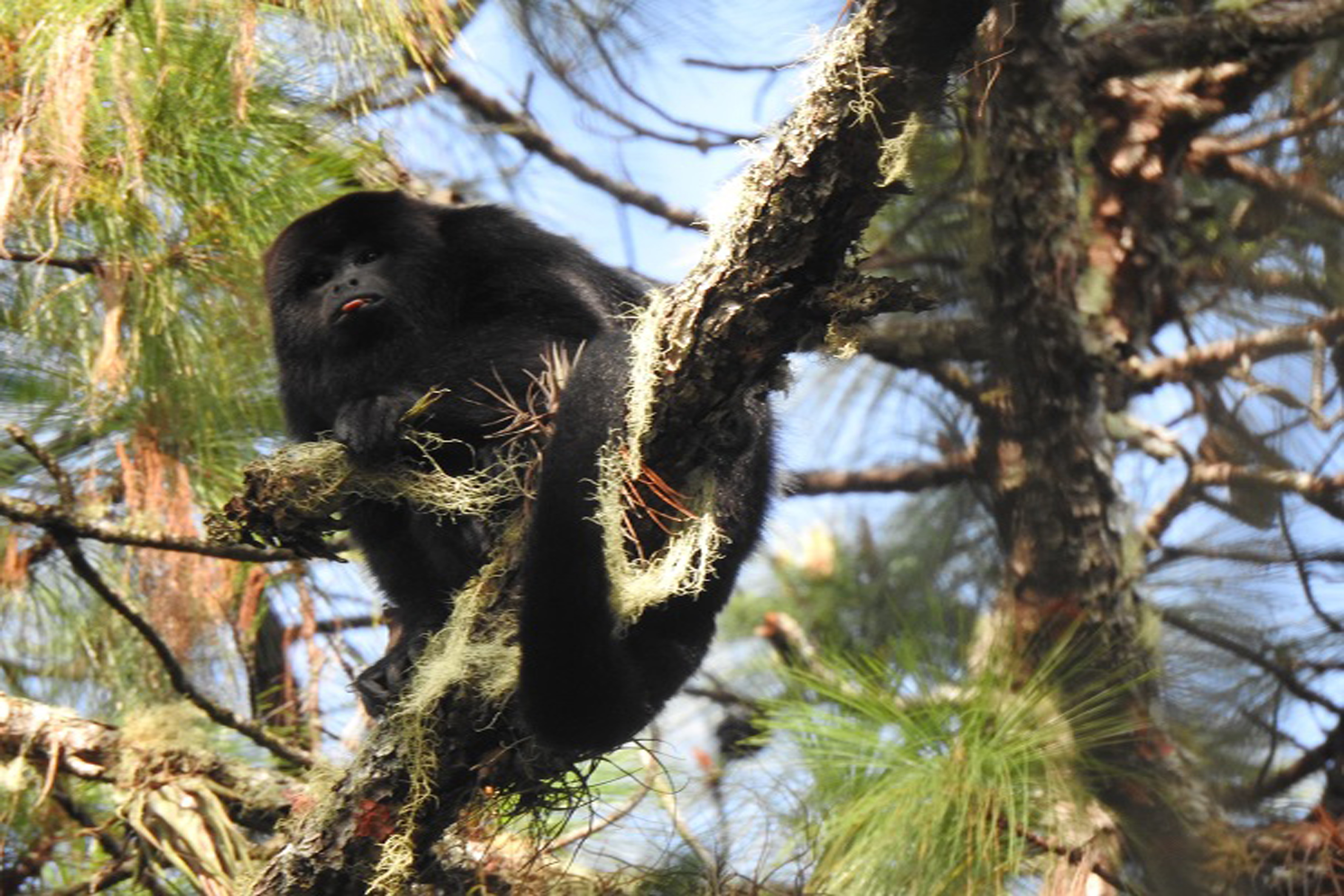Abstract
During December 2020, we documented the presence of an adult male black howler monkey (Alouatta pigra) in a pine-oak forest of the Lagunas de Montebello National Park, in the Central Plateau of Chiapas, Mexico. For a period of 14 days, the individual moved 636.5 m in an altitude range between 1,483 and 1,510 masl. This is one of the highest altitude records for this species in Mexico and a contribution to the knowledge of the mastofauna of the Lagunas de Montebello National Park.
References
Ankel-Simons, F. 2007. Primate Anatomy. An Introduction. Academic Press Inc., San Diego, EUA.
Arroyo-Rodríguez, V. y P.A.D. Dias. 2010. Effects of habitat fragmentation and disturbance on howler monkeys: A review. American Journal of Primatology, 72:1-16. [https://doi.org/10.1002/ajp.20753]
Arroyo-Rodríguez, V., I.M. González-Pérez, A. Garmendia, M. Solà y A. Estrada. 2013. The relative impact of forest patch and landscape attributes on black howler monkey populations in the fragmented Lacandona rainforest, Mexico. Landscape Ecology, 28:1717-1727. [https://doi.org/10.1007/s10980-013-9929-2]
Baumgarten, A. y G.B. Williamson. 2007a. The distributions of howling monkeys (Alouatta pigra and A. palliata) in southeastern Mexico and Central America. Primates, 48:310-315. [https://doi.org/10.1007/s10329-007-0049-y]
Baumgarten, A. y G.B. Williamson. 2007b. Distribution of the black howler monkey (Alouatta pigra) and the mantled howler monkey (Alouatta palliata) in their contact zone in eastern Guatemala. Neotropical Primatology, 14:11-18. [https://doi.org/10.1896/044.014.0103]
Bonilla-Sánchez, Y.M., J.C. Serio-Silva, G. Pozo-Montuy y N. Bynum. 2010. Population status and identification of potential habitats for the conservation of the endangered black howler monkey Alouatta pigra in northern Chiapas, Mexico. Oryx, 44:293-299. [https://doi.org/10.1017/S0030605310000025]
Calixto-Pérez, E., J. Alarcón-Guerrero, G. Ramos-Fernández, P.A.D. Dias, A. Rangel-Negrín, M. Améndola-Pimienta, C. Domingo, V. Arroyo-Rodríguez, G. Pozo-Montuy, B. Pinacho-Guendulain, T. Urquiza-Hass, P. Koleff y E. Martínez-Meyer. 2018. Integrating expert knowledge and ecological niche models to estimate Mexican primates’ distribution. Primates, 59:451-467. [https://doi.org/10.1007/s10329-018-0673-8]
conabio (Comisión Nacional para el Conocimiento y Uso de la Biodiversidad). 2018. Sistema nacional de información sobre biodiversidad (snib). Registros de ejemplares. Alouatta villosa. Publicación en Geoportal y Enciclovida. Disponible en: < https://enciclovida.mx/especies/34839-alouatta-villosa>. [Consultado el 20 de abril de 2021].
conabio (Comisión Nacional para el Conocimiento y Uso de la Biodiversidad)-amp (Asociación Mexicana de Primatología). 2011. Alouatta pigra (mono aullador negro). Distribución potencial, escala 1:1000000. Disponible en: <http://www.conabio.gob.mx/informacion/metadata/gis/alouatpigw.xml?_httpcache=yes&_xsl=/db/metadata/xsl/fgdc_html.xsl&_indent=no>. [Consultado el 19 de abril de 2021].
Cortes-Ortiz, L., A.B. Rylands y R.A. Mittermeier. 2015. The taxonomy of howler monkeys: Integrating old and new knowledge from morphological and genetic studies. Pp. 55-84, en: Howler monkeys. Adaptive radiation, systematics, and morphology. (Kowaleski, M. M., P.A. Garber, L. Cortes-Ortiz, B. Urbani y D. Youlatos, eds.). Springer, Nueva York, eua.
Curdts, T. 1993. Distribución geográfica de las dos especies de mono zaraguate que habitan en Guatemala: Alouatta palliata y Alouatta pigra. Pp. 317-329, en: Estudios primatológicos en México, Vol. 1. (Estrada, A., E. Rodríguez-Luna, R. López-Wilchis y R. Coates-Estrada, eds.). Universidad Veracruzana, Xalapa, México.
Dias, P.A.D., A. Coyohua, A. Rangel-Negrín y D. Canales-Espinosa. 2011. Plants consumed by black howlers in the state of Campeche, Mexico. Pp. 27-46, en: Perspectivas en primatología mexicana (Gama-Campillo, L., G. Pozo-Montuy, W.M. Contreras-Sánchez y S. L. Arriaga-Weiss, eds.). Universidad Juárez Autónoma de Tabasco, Villahermosa, México.
Estrada, A., S. Van Belle, L. Luecke y M. Rosales. 2006. Primate populations in the protected forests of maya archaeological sites in southern Mexico and Guatemala. Pp. 471-488, en: New perspectives in the study of mesoamerican primates. Developments in primatology: Progress and prospects (Estrada, A., P.A. Garber, M.S.M. Pavelka y L. Luecke, eds.). Springer, Boston, eua.
Estrada, A., P.A. Garber, A.B. Rylands, C. Roos, E. Fernandez-Duque, A. Di Fiore, K.A. Nekaris, V. Nijman, E.W. Heymann, J.E. Lambert, F. Rovero, C. Barelli, J.M. Setchell, T.R. Gillespie, R.A. Mittermeier, L.V. Arregoitia, M. de Guinea, S. Gouveia, R. Dobrovoloski, S. Shanee, N. Shanee, S.A. Boyle, A. Fuentes, K.C. McKinnon, K.R. Amato, A.L.S. Meyer, S. Wich, R.W. Sussman, R. Pan, I. Kone y B. Li. 2017. Impending extinction crisis of the world´s primates: Why primates matter. Science Advances, 3:e1600946. [https://doi.org/10.11126/sciadv.1600946]
Heymann, E.W., L. Culot, C. Knogge, A.C. Smith, E.R. Tirado-Herrera, B. Müller, M. Stojan-Dolar, Y. Lledo-Ferrer, P. Kubisch, D. Kupsch, D. Slana, M.L. Koopmann, B. Ziegenhagen, R. Bialozyt, C. Mengel, J. Hambuckers y K. Heer. 2019. Small neotropical primates promote the natural regeneration of anthropogenically disturbed areas. Scientific Reports, 9:10356. [https://doi.org/10.1038/s41598-019-46683-x]
Ho, L., L. Cortez-Ortiz, P.A.D. Dias, D. Canales-Espinosa, D.M. Kitchen y T.J. Bergman. 2014. Effect of ancestry on behavioral variation in two species of howler monkeys (Allouatta pigra and A. palliata) and their hybrids. American Journal of Primatology, 76:855-867. [https://doi.org/10.1002/ajp.22273]
Horvath, A., R. Vidal-López, O. Pérez-Macías, C. Chávez-Gloria, Y. Aguirre-Bonifaz, D. Gallegos-Castillo, M. Ramírez Lozano, E. Sánchez-Vázquez y E. Espinoza-Medinilla. 2008. Mamíferos de los parques nacionales Lagunas de Montebello y Palenque. Informe final del proyecto BK047. conabio/ecosur, San Cristóbal de las Casas, Chiapas, México.
iucn (International Union for Conservation of Nature). 2021. The iucn Red List of Threatened Species. Version 2021-1. Disponible en: https://iucnredlist.org (Consultado el 16 abril 2021).
Kelaita, M., P.A.D. Dias, M.S. Aguilar-Cucurachi, D. Canales-Espinosa y L. Cortes-Ortiz. 2011. Impact of intrasexual selection on sexual dimorphism and testes size in the mexican howler monkeys Alouatta palliata and A. pigra. American Journal of Physical Anthropology, 146:79-187. [https://doi.org/10.1002/ajpa.21559]
Klass, K., S. Van Belle y A. Estrada. 2020. Demographic population structure of black howler monkeys in fragmented and continuous forest in Chiapas, Mexico: Implications for conservation. American Journal of Primatology, 82:e23163. [https://doi.org/10.1002/ajp23163]
Muñoz, D., A. Estrada y E. Naranjo. 2005. Monos aulladores (Alouatta palliata) en una plantación de cacao (Theobroma cacao) en Tabasco, México: aspectos de la ecología alimentaria. Universidad y Ciencia, No. Especial 2:35-44.
Oropeza-Hernández, P. y E. Rendón-Hernández. 2012. Programa de acción para la conservación de las especies: Primates, mono araña (Ateles geoffroyi) y monos aulladores (Alouatta palliata y Alouatta pigra). Secretaría de Medio Ambiente y Recursos Naturales/Comisión Nacional de Áreas Naturales Protegidas. México D.F.
Ramírez-Pulido, J., N. González-Ruiz, A.L. Gardner y J. Arroyo-Cabrales. 2014. List of recent land mammals of Mexico, 2014. Special Publications, Number 63. Museum of Texas Tech University, Lubbok, Texas, EUA.
Semarnat (Secretaría de Medio Ambiente y Recursos Naturales). 2007. Programa de conservación y manejo. Parque Nacional Lagunas de Montebello. Secretaría de Medio Ambiente y Recursos Naturales/Comisión Nacional de Áreas Naturales Protegidas. D.F., México.
Semarnat (Secretaría de Medio Ambiente y Recursos Naturales). 2019. Modificación del Anexo Formativo III, Lista de Especies en Riesgo de la Norma Oficial Mexicana NOM-059-SEMARNAT-2010, Protección Ambiental-Especies nativas de México de flora y fauna silvestres-Categorías de riesgo y especificaciones para su inclusión, exclusión o cambio-Lista de Especies en Riesgo. Diario Oficial de la Federación, 20 de octubre de 2019.
Vidal-García, F. y J. C. Serio-Silva. 2011. Potential distribution of mexican primates: modeling the ecological niche with the maximum entropy algorithm. Primates, 52:261-270. [https://doi.org/10.1007/s10329-011-0246-6].

This work is licensed under a Creative Commons Attribution-NonCommercial-NoDerivatives 4.0 International License.
Copyright (c) 2021 Revista Mexicana de Mastozoología (nueva época)



